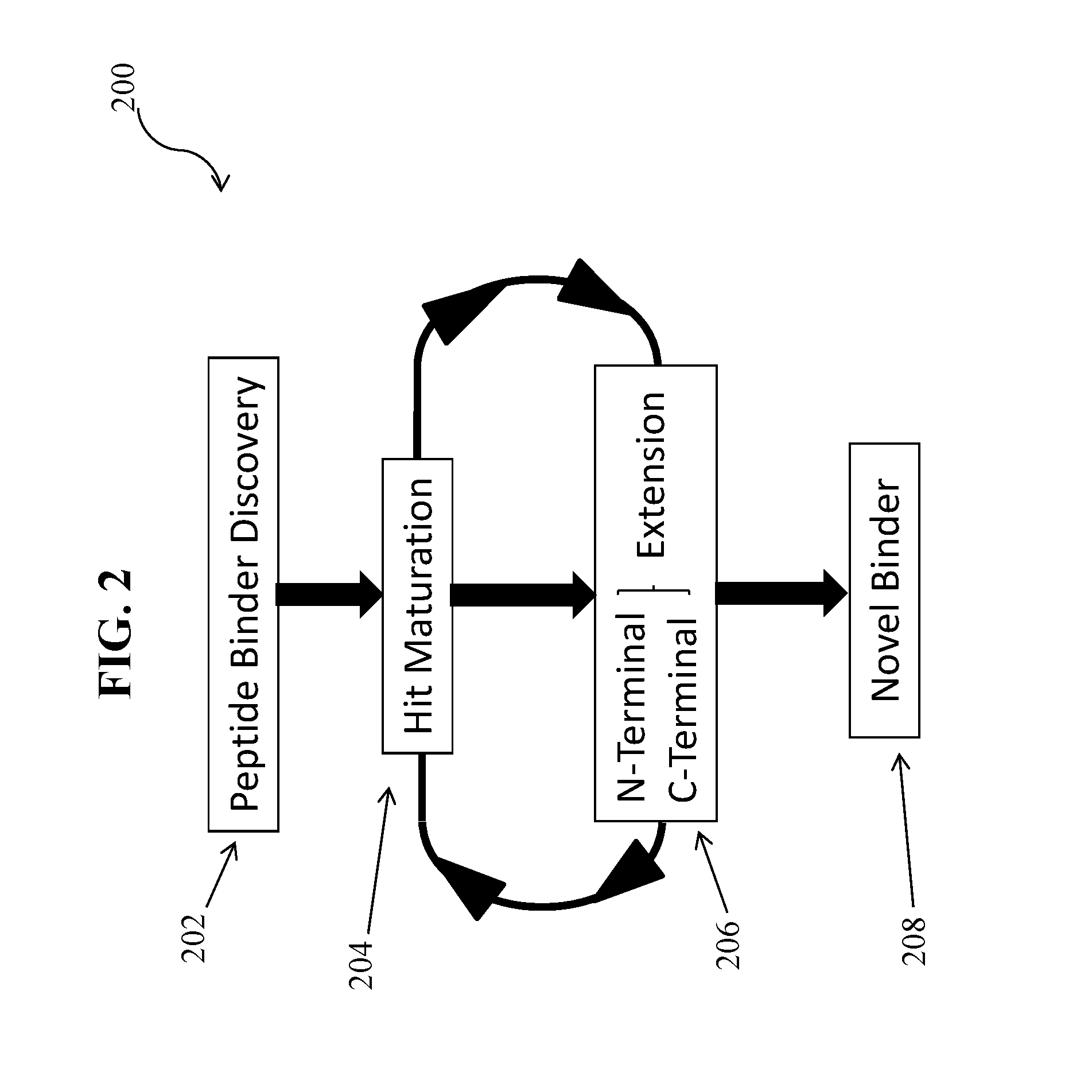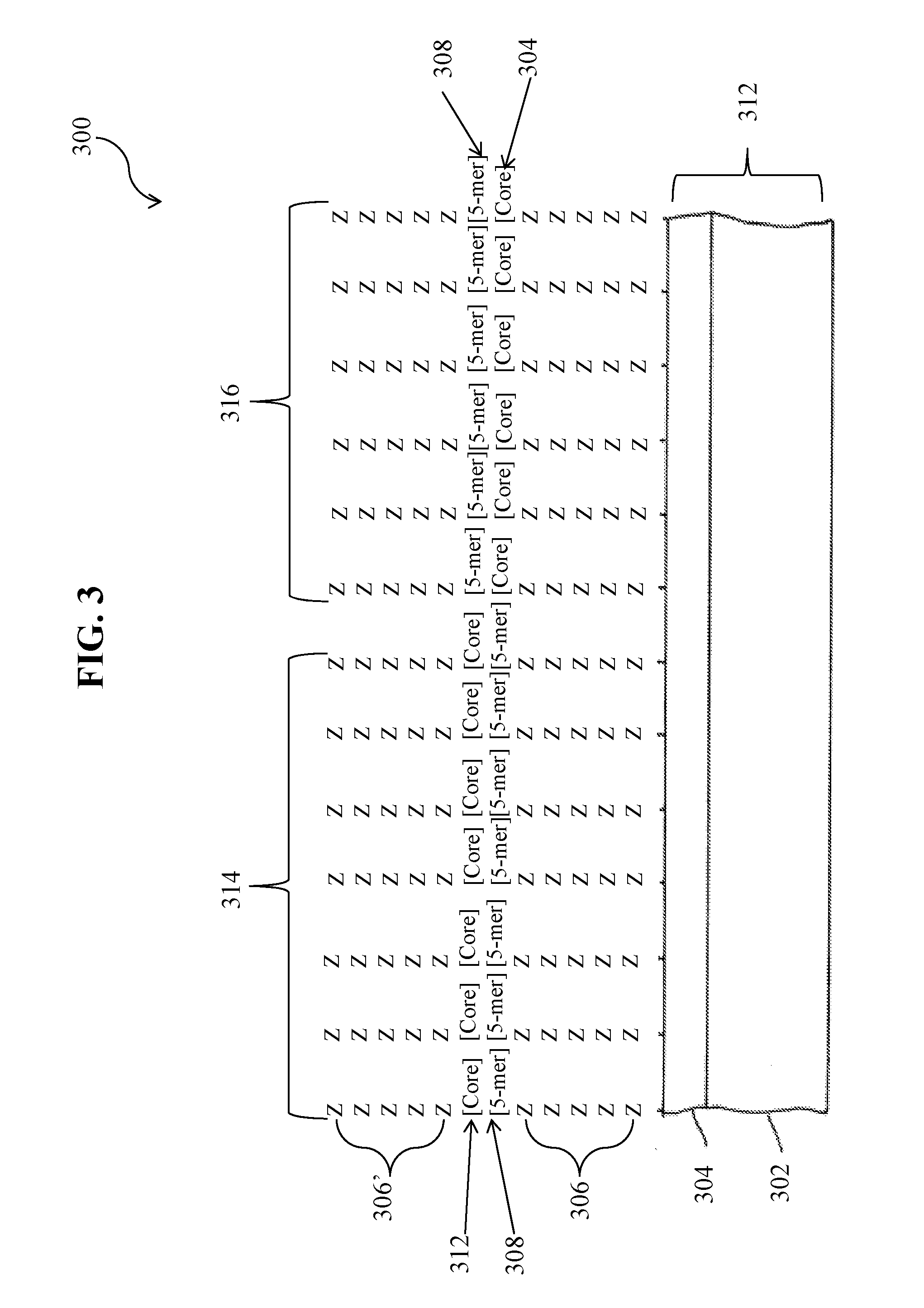Specific peptide binders to proteins identified via systemic discovery, maturation and extension process
a technology of systemic discovery and peptide binders, applied in the direction of peptides, instruments, material analysis, etc., can solve the problems of insufficient assurance, limited application of such methods to de novo discovery of peptide binders, and high cos
- Summary
- Abstract
- Description
- Claims
- Application Information
AI Technical Summary
Benefits of technology
Problems solved by technology
Method used
Image
Examples
example 1
Streptavidin Binders
Library Synthesis
[0104]To create a library of peptides, an array of 5-mer peptides synthesized with 18 natural amino acids excluding Cys and Met, any repeat of two or more of the same amino acid, as well as any peptide containing HR, RH, HK, KH, RK, KR. HP, and PQ sequences to identify binders to streptavidin other than other the known HPQ- and HPM-like motifs. The arrays were synthesized with Z linkers (Z is synthesized using a 3:1 mixture of Gly and Ser) or J linkers (J is synthesized using an equimolar mixture of all 20 natural amino acids) and bound to 0.3 μg / ml Cy5-labeled streptavidin in 1×TE binding buffer with 1% alkali soluble casein in the presence of 0.05% Tween 20 at 4° C. overnight. Table 8 shows results of streptavidin binding to the 5-mer library synthesized with different linkers.
TABLE 8Secondary SA binder core motifs selected using 5-mer libraries with different linkersLinkerTop 5-mer sequences excludingtypeHPQ and RPM motifs3ZLAEYH (SEQ ID NO: 1...
example 2
Prostate-Specific Antigen (PSA) Binders
[0107]We optimized sequence of peptide binders to PSA by using data for the 5-mer array library with 5Z linker and extension arrays with 3Z linker described earlier and performing more extensive substitution / deletion experiments. The results are shown in Table 10.
TABLE 10PSA bindersSequencesSequencesSequencesselected fromDoubleselected fromselected from Extensionextensionsubstitution / de-substitution / de-5-mer librarieslibrarieslibrariesletion librariesletion librariesFEVYLXXFEVYLXXNGFEVYLPGGNGFEVYLPGGG[GN]QFEVYIPGA(SEQ ID NO: 40)(SEQ ID NO: 129)(SEQ ID NO: 130)(SEQ ID NO: 131)(SEQ ID NO: 134)GQFEVYLPGGGQFEVYLPGGGTDFEVYFPKI(SEQ ID NO: 41)(SEQ ID NO: 132)(SEQ ID NO: 135)TDFEVYLPKGTDFEVYLPKG(SEQ ID NO: 42)(SEQ ID NO: 133)WTVYAXXWTVYAXXSEWTVYAGNGSEWTVYAGNGASEWTVYAGN[GK](SEQ ID NO: 45)(SEQ ID NO: 136)(SEQ ID NO: 46)(SEQ ID NO: 137)(SEQ ID NO: 139)GDWTVYAGNGGDWTVYAGNGAGDWTVYAGLG(SEQ ID NO: 47)(SEQ ID NO: 138)(SEQ ID NO: 49)ALDWQVYAGFG(SEQ ID NO: 50)WE...
example 3
Thrombin Binders
[0108]We used the 5-mer arrays library with 3Z linker, then extension arrays with 3Z linker and substitution / deletion libraries to identify peptide binders to thrombin as shown in Table 11. Maturation experiments are in progress.
TABLE 11Thrombin bindersSequencesSequencesselected fromDoubleselected fromExtensionextensionsubstitution / de-5-mer librarieslibrarieslibrariesletion librariesPINLGXXPINLGXXWAPINLGQRGWAPINLGQRG(SEQ ID NO: 57)(SEQ ID NO: 151)(SEQ ID NO: 58)(SEQ ID NO: 152)PAPINLGNRGPAPINLGNRG(SEQ ID NO: 59)(SEQ ID NO: 153)VPIRLXXVPIRLXXYAVPIRLGAQYAVPIRLGAG(SEQ ID NO: 60)(SEQ ID NO: 154)(SEQ ID NO: 61)(SEQ ID NO: 155)WPINLXXWPINLXXRYWPINLGKGRYWPINLGKG(SEQ ID NO: 62)(SEQ ID NO: 156)(SEQ ID NO: 63)(SEQ ID NO: 157)YRWPINLGKGYRWPINLGKG(SEQ ID NO: 64)(SEQ ID NO: 158)APVRLXXAPVRLXXKYAPVRLGSGKYAPVRLGSG(SEQ ID NO: 65)(SEQ ID NO: 159)(SEQ ID NO: 66)(SEQ ID NO: 160)RQIFLXXRQIFLXXDGRQIFLQKGDGRQIFLQKG(SEQ ID NO: 67)(SEQ ID NO: 161)(SEQ ID NO: 68)(SEQ ID NO: 162)PIRLKXXPIRLKX...
PUM
| Property | Measurement | Unit |
|---|---|---|
| Fraction | aaaaa | aaaaa |
| Dissociation constant | aaaaa | aaaaa |
| Dissociation constant | aaaaa | aaaaa |
Abstract
Description
Claims
Application Information
 Login to View More
Login to View More - R&D
- Intellectual Property
- Life Sciences
- Materials
- Tech Scout
- Unparalleled Data Quality
- Higher Quality Content
- 60% Fewer Hallucinations
Browse by: Latest US Patents, China's latest patents, Technical Efficacy Thesaurus, Application Domain, Technology Topic, Popular Technical Reports.
© 2025 PatSnap. All rights reserved.Legal|Privacy policy|Modern Slavery Act Transparency Statement|Sitemap|About US| Contact US: help@patsnap.com



